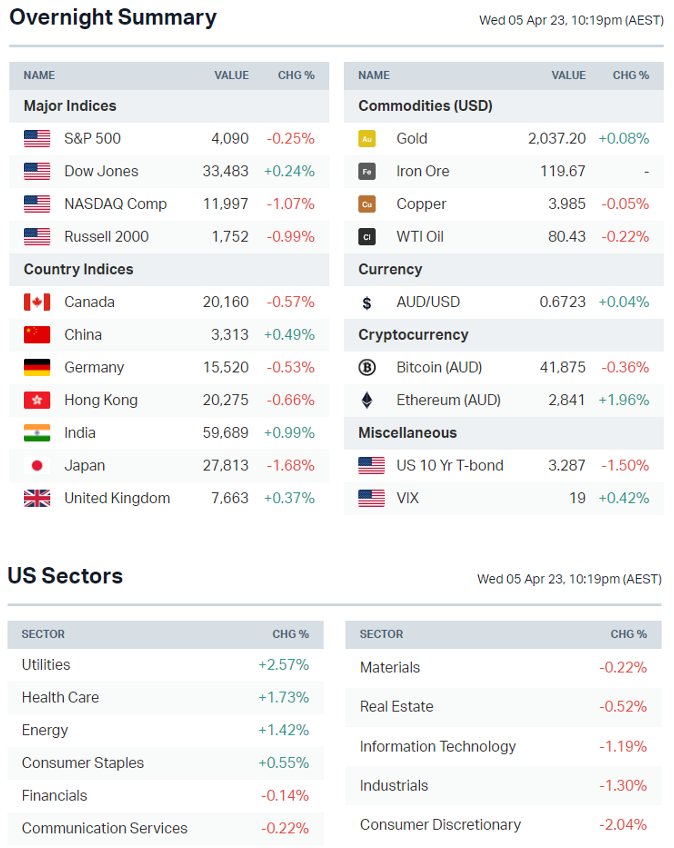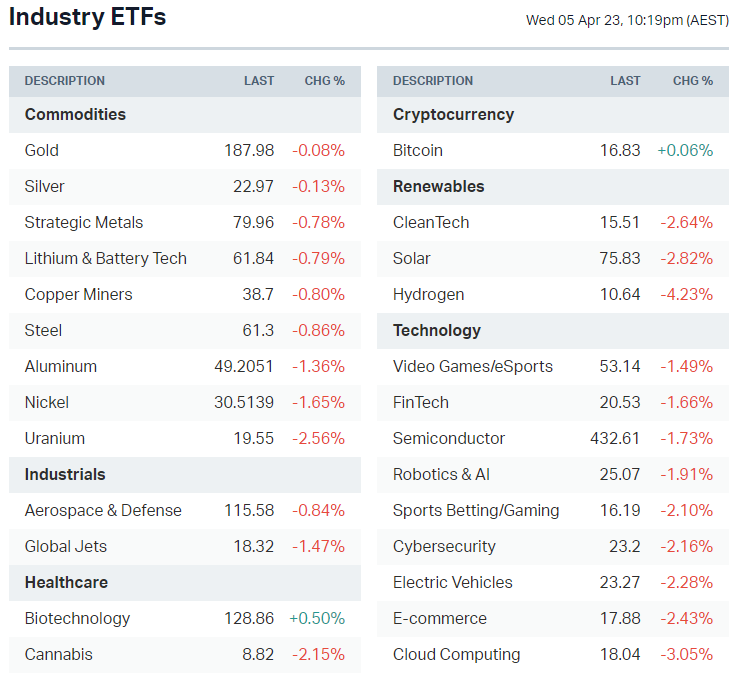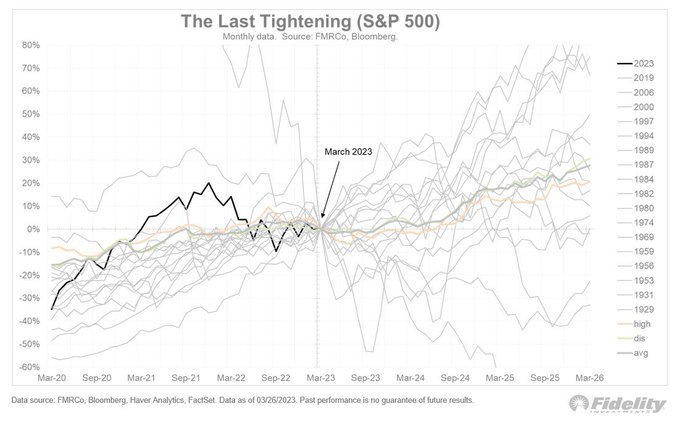Dow higher, S&P 500 sinks as recession jitters escalate, ASX 200 futures fall
ASX 200 futures are trading 7 points lower, down -0.01% as of 8:20 am AEDT.
The blue-chip Dow pulls ahead as Utilities, Healthcare and Staples finish the session higher, US services sector PMIs miss expectations by a wide margin, gold continues to hold above US$2,000 an ounce, key takeaways from JPMorgan's Annual Letter and some sectors and charts to watch. Oh and the Wraps will be taking a break on Good Friday and Easter Monday, so have a wonderful break and we'll see you next Tuesday.
Let's dive in.

Source: Market Index
S&P 500 SESSION CHART

S&P 500 falls but finished off session lows (Source: TradingView)
MARKETS
- S&P 500 lower but closes off session lows of -0.68%
- Risk-off tone sees growth sectors sell off and defensives outperform
- Retail investors ramp up purchases of banks (Bloomberg)
- Gold hovers above US$2,000 with record high now in sight (Bloomberg)
- US dollar to slip as peers catch up in rates race (Reuters)
- Bond market volatility remains an overhang for markets (Bloomberg)
- Fixed-income ETFs continue to accrue popularity among investors (CNBC)
STOCKS
- J&J (+4.5%): To settle US$8.9bn to settle talc-cancer complaints from ~60,000 claimants
- Walmart (+1.7%): Reaffirmed first-quarter and full-year guidance, targeting 65% of its stores to be serviced by automation by FY26, which will lower average unit costs by 20%
- Nvidia (-2.1%): Shares fell after Google revealed details about its AI supercomputer, which it claims is 1.2-1.7 times faster, uses 1.3-1.9 times less power than Nvidia A100
- Albemarle (-6.1%): BofA downgraded the stock to Underperform from Neutral.
- Western Alliance Bank (-12.4%): Deposits fell by a smaller-than-expected 11%, reaffirmed enough liquidity to cover the remaining uninsured deposits
ECONOMY
- US services sector growth slows, price pressures abating (Reuters)
- US private payrolls rose 145,000 in March, well below expectations (CNBC)
- German factory orders unexpectedly rise strongly, add to promising signals (AP)
- RBNZ surprises market with 50 bps rate hike (Reuters)
- RBA Governor Lowe says April pause does not imply rate hikes are over (Bloomberg)
- Cleveland Fed Pres Mester sees rates moving above 5% and staying there (Bloomberg)
-
VC funding in start-up halves as tech downturn bites (FT)

Overnight US-listed sector ETF performance (Source: Market Index)
Deeper Dive
Recession Narrative Gathers Momentum
Growth worries continue to accelerate as US ISM Services PMI was 51.2 in March from 55.1 in the previous month and below expectations of 54.4. This was after job openings in the JOLTS report fell more than expected on Wednesday and the weakest ISM manufacturing print in nearly three years on Tuesday.
The services sector is a pretty big deal as it makes up approximately 77% of the US economy. Here are some key takeaways from the report:
- Business activity: ISM's Business Activity Index registered 55.4%, with 14 industries reporting an increase in business activity for March.
- New orders: ISM's New Orders Index registered 52.2%, with 12 industries reporting growth of new orders in March.
- Prices: Prices paid by services organizations registered 59.5%, with 13 services industries reporting an increase in prices paid during March. This was the first under 60 reading since September 2020 and lowest since July 2020.
- New Export Orders: The New Export Orders Index registered 43.7%, an 18-percentage point decrease from February, with four industries reporting an increase in new export orders in March.
Jamie Dimon's Annual Letter
Most of Wall Street's most prominent investors release annual letters. Today, it's the turn of Jamie Dimon of JPMorgan Chase & Co. The big theme of his letter to shareholders was that the market's most threatening clouds "are still here", and that the future is both "new and uncertain". Here are some key quote takeaways:
- On SVB and Credit Suisse: "Most of the risks were hiding in plain sight ... It is unlikely that any recent change in regulatory requirements would have made a difference in what followed."
- "The current crisis is not yet over, and even when it is behind us, there will be repercussions from it for years to come."
- On recent short-term volatility: "It should be noted that an inordinate amount of attention is focused on short-term interest rates, which the Fed affects directly. But the Fed does not completely control long-term rates and liquidity, which are influenced by both supply and demand (QT) and global investor preferences and sentiment."
- On recession: "As someone once said, an inverted yield curve like this is “eight for eight” in predicting a recession in the next 12 months. However, it may not be true this time because of the enormous effect of QT."
- On the uncertainty posed by the Russian invasion of Ukraine: "This may be a once-in-a-generation sea change, with material effect. Of course, there is always uncertainty. I am often frustrated when people talk about today’s uncertainty as if it were any different from yesterday’s uncertainty. However, in this case, I believe it actually is."
Charts to Watch
1. Does the last tightening really herald a new bull market in equities?
Jurrien Timmer of Fidelity International recently published this chart in response to a Goldman Sachs chart covering the same material. The question is to do with whether the S&P 500 will enter a bull market following the last rate rise from the Federal Reserve. The Goldmans chart goes as far back as 1984, and argues that in most cases, S&P 500 returns do climb significantly in the 12 months following a pause. But if you go back further to 1929, as Jurrien has done, that picture is far more complicated than it seems at first.

Source: Fidelity
2. Last year's losers are this year's winners.... so far
And speaking of Goldman Sachs, this chart caught my interest. The top 20 S&P 500 performers in the first quarter were all of last year's losers - namely the mega cap tech stocks + Tesla. As someone put it online, it's the "buy-the-dip-of-the-dip-of-the-dip" narrative. This chart looks at where certain asset classes returned in 2022 and how they are doing so far in 2023. Pay attention to the top left hand side of that chart especially.

Source: Goldman Sachs
Sectors to Watch
Another somewhat uneventful session overnight. We're starting to see defensive sectors like Utilities, Healthcare and Staples outperform again on Wall St, which might reflect a pivot back into defensive pockets of the market.
- Tech: Growthy sectors led the downside overnight. The Global X Cloud ETF was down 3.1% and Fintech down 1.7%. The ASX 200 Info Tech Index is getting pretty extended after rallying for six straight days, up 6.8%. Does a pullback start to take place for names like Wisetech, Xero and Altium?
- Defensives: As we noted above, the blue-chip Dow is starting to outperform. Do we see a similar trend for local Utilities, Healthcare and Staples names?
- Energy: Oil prices were relatively flat overnight but the S&P 500 Energy sector rose 1.4%.
- Gold: Gold was also flat overnight, settling around US$2,020 an ounce. Most ASX-listed gold names rallied strongly on Wednesday, so let's see what day two of the move out looks like.
Key Events
ASX corporate actions occurring today:
- Trading ex-div: Brickworks (BKW) – $0.23, Diverger (DVR) – $0.02
- Dividends paid: McPherson’s (MCP) – $0.02, Adairs (ADH) – $0.08, Atlas Arteria (ALX) – $0.20, Fletcher Building (FBU) – $0.168, Cleanaway Waste Management (CWY) – $0.0245, Shriro (SHM) – $0.035, NRW Holdings (NWH) – $0.085, InvoCare (IVC) – $0.11, Monash IVF (MVF) – $0.022
- Listing: None
Economic calendar (AEST):
- 11:30 am: Australia Balance of Trade
- 11:30 am: RBA Financial Stability Review
- 11:45 am: China Services PMI
- 10:30 pm: Canada Unemployment Rate
This Morning Wrap was first published for Market Index and written by Hans Lee and Kerry Sun.
2 contributors mentioned

